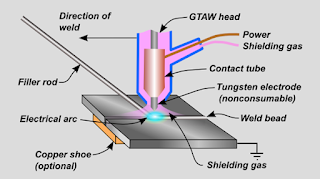Gas tungsten arc welding or GTAW is the same as tungsten inert gas or TIG welding. It is also an arc welding process. Here a non-consumable electrode is used. And most importantly - the electrode is made of tungsten. And this electrode helps to produce the weld. The weld area is protected from atmospheric contamination or oxidation by usually an inert gas. This shielding gas is generally argon. Autogenous welds are not required in this process.
Here energy is supplied by a constant current welding power source. This power supply produces energy which is conducted through a column of ionized gas accompanied by metal vapors. These are known as plasma.
If this welding is done manually then it is one of the most complex welding processes. This process is difficult in industrial level because the welder has to maintain a short arc length. Great skill and care is needed to conduct the operation without any contact between electrode and workpiece. In GTAW the welder has to use both the hands. Welder has to put the filler metal manually and also maintain the torch. Some materials can be welded without the filler metal (autogenous or fusion).
Here energy is supplied by a constant current welding power source. This power supply produces energy which is conducted through a column of ionized gas accompanied by metal vapors. These are known as plasma.
If this welding is done manually then it is one of the most complex welding processes. This process is difficult in industrial level because the welder has to maintain a short arc length. Great skill and care is needed to conduct the operation without any contact between electrode and workpiece. In GTAW the welder has to use both the hands. Welder has to put the filler metal manually and also maintain the torch. Some materials can be welded without the filler metal (autogenous or fusion).
Advantages of GTAW
- No flux is used
- No danger of flux entrapment when the welding of refrigerator or air conditioner takes place.
- Better control by the operator because of better visibility.
- Very few splatters. Very high quality and smooth welds.
Disadvantages of GTAW
- Under similiar conditions MIG welding is much more faster process.
- Tungsten if gone to the molten weld then it can contaminate the pool.
- Equipments are costly.
Applications
- Aluminium, magnesium, copper alloys can be welded easily. Inconel, carbon steels, stainless steels can be welded.
- Thin parts and sheet metals can be welded easily.
- Can sealing, instrument diaphragms and transistor cases can be welded very efficiently.
- Expansion bellows and other delicate parts can joined.
- Atomic energy, aircraft, chemical and instrument industries use this welding process.
- Rocket motor chamber fabrication welding can be done by this process.
- Different Types of Welding Defects
- Advantages and disadvantages of Submerged Arc welding
- Flux shielded metal arc welding process principle
- Gas Metal Arc Welding (GMAW) or MIG Welding
- Submerged Arc Welding principle
- Resistance Spot Welding Working Principles with merits and demerits
- Resistance Seam Welding Advantages and Disadvantages






ReplyDeleteA wonderful blog.
We get great data from this blog.
Welding Gauge
Great Blog
ReplyDeleteElectric resistance welding
ReplyDeleteThe world owes the invention of electric resistance and spot welding to Englishman Elihu Thomson. This engineer has several patents in the field of spot welding to his name.
Electric resistance welding consists in assembling by autogenous fusion the parts to be welded under the pressure of two metal parts. Who says welding says heat, with resistance welding the heat necessary for welding is provided by the Joule effect (which is the thermal manifestation of electrical resistance, this heat occurs when an electric current passes through any material conductor) of a current of high intensity and low voltage, passing through the parts to be assembled. Indeed, it takes a lot of amps and little voltage. The application of a forging force makes it possible to ensure the metallic interpenetration.
resistance welding